Several Utilities in Minnesota offer rebates or incentives for the installation of solar PV systems, listed below.
Some utilities may also cover other renewable energy options, like solar thermal, geothermal, or biomass.
- Austin Utilities: Conserve & Save Solar Rebates
- Brainerd Public Utilities: Solar Rebate
- Dakota Electric: Solar Rebate
- Minnesota Power: SolarSense
- Owatonna Public Utilities: Conserve & Save Solar Rebates
- Rochester Public Utilities: Conserve & Save Solar Rebates
- Xcel Energy: Solar*Rewards

